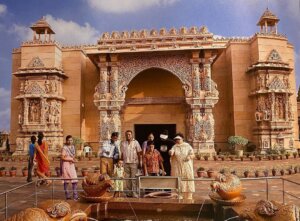Akshardham Temple: A Spiritual Oasis in the Heart of India
Akshardham Temple: An Architectural and Spiritual Marvel
Introduction
Swaminarayan Akshardham, a Hindu temple and cultural complex near the Noida border in Delhi, India, is a millennium-old testament to Hindu culture, spirituality and architecture. Inaugurated by Pramukh Swami Maharaj on 6 November 2005, it is the second largest BAPS Hindu temple in the world. Built by BAPS, inspired by Yogi ji Maharaj and designed as per Vaastu Shastra and Pancharatra Shastra, the complex centers around the Akshardham Temple.

The Akshardham Temple, towering at 141 feet, is a breathtaking fusion of Rajasthani pink sandstone and Italian Carrara marble, adorned with intricate carvings depicting flora, fauna, and Hindu deities. Guided by Hindu architectural principles, it boasts 234 exquisitely crafted pillars, nine majestic domes, and over 20,000 sculptures. At its heart lies an imposing 11-foot statue of Swaminarayan, encircled by inspiring depictions of the faith’s revered gurus. Beyond its spiritual magnificence, the temple offers visitors a journey through exhibition halls, a mesmerizing water show, and themed gardens, rendering it a sanctuary of spiritual enrichment and cultural exploration.
Architectural Marvel: Akshardham Temple
Exploring the architectural masterpiece of Akshardham Temple
- Traditional Indian Artistry:
- Akshardham Temple stands as a testament to the rich tapestry of traditional Indian artistry. The architecture is deeply rooted in the country’s cultural and religious heritage, drawing inspiration from ancient design principles and artistic techniques Akshardham Temple.
- Ornate Carving:
- One of the most striking features of Akshardham Temple is the abundance of ornate carvings that adorn its walls, pillars and domes. The artisans have meticulously carved intricate patterns, floral motifs and mythological scenes, displaying a level of craftsmanship that reflects a dedication to preserving the aesthetic essence of India’s artistic heritage.
- Symbolic Elements:
- Architectural details are not merely decorative; They have deep symbolic significance. The elaborate carvings depict gods, saints and mythological narratives, each telling a story and imparting spiritual teachings. The temple becomes a living repository of symbolic elements that connect visitors to the cultural and religious roots inherent in every stone.
- Majestic Dome:
- The majestic domes of Akshardham Temple are architectural marvels that dominate the skyline. Intricately designed and adorned with decorative elements, these domes not only serve as architectural focal points but also symbolize spiritual significance, drawing the eyes of worshipers and visitors to the divine realms.
- Blend of Modern Technology:
- Despite being rooted in tradition, the architecture of Akshardham Temple seamlessly incorporates modern technology. The marriage of age-old craftsmanship with contemporary engineering results in a harmonious fusion, creating a temple that not only pays homage to the past but also embraces the progress of the present.
- Reflecting Pool and Landscaped Garden:
- Architectural genius extends beyond the main structure to the surrounding environment. The reflecting pool and meticulously landscaped gardens add to the overall aesthetic appeal. These elements not only serve as a visual delight but also contribute to the spiritual ambiance, creating a tranquil oasis within the bustling city.
- Precision and Symmetry:
- Meticulous attention to precision and symmetry of the architectural layout are notable aspects of Akshardham’s design. Each element has been thoughtfully placed to create a sense of balance and harmony, reflecting the spiritual principles behind the construction of the temple.
- Influence of Vaastu Shastra:
- Akshardham follows the principles of the ancient Indian architectural science, Vaastu Shastra. The layout, orientation and proportions of the temple have been carefully planned to align with cosmic energy, ensuring a sacred and spiritually uplifting space.
- Artisan Heritage:
- The artisans who contributed to the construction of Akshardham Temple have carried forward a legacy of craftsmanship that spans generations. Their skill, honed over time, is manifested in the intricate details that make the temple an architectural gem and a testament to the enduring spirit of India’s artisan traditions.
Cultural Tapestry:
Exhibitions unveiling art, history and values at Akshardham Temple
1. Artistic Showcase:
– Akshardham Temple hosts a series of captivating exhibitions that serve as windows into India’s rich artistic heritage. These showcases bring together diverse forms of traditional and contemporary art, offering a visual feast to visitors. From intricate sculptures to vibrant paintings, each exhibition is a celebration of the country’s artistic prowess.
2. Historical narrative:
– Akshardham’s exhibitions delve into the depths of India’s history, highlighting stories passed down over centuries. Through immersive storytelling and visual content, visitors are taken on a journey that uncovers the historical tapestry of the nation. Exhibitions often showcase important events, historical figures and the development of Indian civilization.
3. Cultural Values and Traditions:

– At the heart of the exhibitions are the cultural values and traditions that have shaped the ethos of India. Visitors get to see exhibits that highlight the importance of unity in diversity, tolerance and the age-old wisdom embedded in the philosophical teachings of the country. These values serve as guiding principles, promoting a deep understanding of the cultural fabric of India.
4. Mythological Insight:
– Several exhibitions provide an insight into Indian mythology, showcasing stories from epics such as the Ramayana and the Mahabharata. Intricately designed dioramas and multimedia presentations bring these ancient tales to life, allowing visitors to immerse themselves in mythological realms that have been an integral part of India’s cultural consciousness.
5. Interactive Display:
– To enhance the visitor experience, some exhibitions include interactive displays. These may include touchscreens, audio guides, and hands-on activities that encourage engagement and participation. Such elements not only make the learning experience more dynamic but also cater to the needs of diverse audiences.
6. Philosophical teachings:
– The Akshardham Temple is deeply rooted in the Swaminarayan tradition, and exhibitions often display the philosophical teachings of Lord Swaminarayan. Visitors gain exposure to the spiritual knowledge, moral values and ethical principles that form the foundation of the Temple’s ethos.
7. Educational Importance:
– Apart from being visually appealing, exhibitions have immense educational value. Schools, scholars and curious minds alike get access to a wealth of information that enriches their understanding of India’s cultural, artistic and historical heritage. The academic aspect is in line with Akshardham’s commitment to being a center of education and knowledge.
8. Temporary Exhibitions and Special Events:
Akshardham Temple organizes temporary exhibitions and special events from time to time which correspond to various themes. These may focus on specific aspects of art, history or cultural practices. Such exhibits contribute to the dynamic nature of Akshardham, ensuring that each visit offers something new and interesting.
9. Conservation of heritage:
Akshardham’s Temple exhibitions contribute to the preservation of India’s heritage by showcasing its artistic achievements and historical milestones. By presenting these elements in a contemporary and accessible format, the temple actively engages in the preservation and promotion of the country’s cultural heritage.
Spiritual Serenity:

Exploring the tranquil paradise of Akshardham Temple
- Gardens with serene landscapes:
As soon as you step into Akshardham, you are welcomed by beautifully landscaped gardens that spread like a green carpet. Meticulously manicured lawns, vibrant flowers and shady trees create a soothing visual sight. Tourists are invited to stroll through these gardens and experience a sense of peace amidst the vibrant colors of nature.
- Reflective pools and water features:
An integral part of the serene environment are the reflecting pools which reflect the architectural grandeur of the temple. These tranquil water bodies adorned with fountains and sculptures contribute to the feeling of peace. The rhythmic flow of water and the play of light on its surface add to the overall meditative atmosphere.
- Prayer Place and Meditation Area:
Akshardham Temple offers dedicated space for prayer and meditation. These areas are designed to provide visitors with secluded corners where they can engage in moments of introspection and spiritual contemplation. The tranquility of these places allows for personal reflection and connection with the divine.
- Architectural symmetry enhances peace:
The architectural layout of Akshardham Temple is characterized by a subtle sense of symmetry and balance. The harmonious arrangement of structures and pathways contributes to a tranquil environment. Visitors often find that the architectural precision itself provides a sense of order and peace.
- Shady pathways and seating areas:
Shady pathways wind through the temple complex, providing shady areas for visitors to relax and enjoy the peaceful atmosphere. Benches and seating areas strategically placed amidst the greenery allow individuals to take some time out to relax, read or simply enjoy the ambiance.
- Scenes of Peace:
Akshardham Temple has been designed to reduce external noise, creating an environment where the sound landscape is composed of gently rustling leaves, distant bird calls and the soft murmur of water. Deliberately reducing auditory distractions increases the overall peace of the temple.
- Artistic elements that promote peace:
Artistic elements within the temple complex, such as sculptures and symbolic structures, contribute to the serene atmosphere. These elements often hold spiritual significance, adding a layer of depth to the tranquil atmosphere and inviting contemplation.
- Natural Elements in Harmony:
Akshardham Temple seamlessly integrates natural elements like stone, wood and plants in its design. The use of natural materials fosters a connection with the environment, fostering a feeling of unity with the earth. This intentional harmony with nature enhances overall peace.
- Temporal Variations:
The serene atmosphere of Akshardham Temple undergoes subtle changes throughout the day. The play of sun and shadow, the coolness of the morning and the stillness of the evening collectively create a dynamic experience for the visitors, ensuring that every moment brings a unique sense of peace.
Devotion and Worship:
Sacred Sanctuary: Akshardham as a place of worship
- Spiritual Refuge:
Akshardham Temple, in its essence, serves as a spiritual heaven where individuals gather to express their devotion, find solace and connect with the divine. It is a place where the spiritual journey begins, evoking a deep sense of reverence and peace.
- Sanctum Sanctorum of Lord Swaminarayan:
The center of the worship experience at Akshardham Temple is the sanctum sanctorum dedicated to Lord Swaminarayan. The idol of the deity is revered, and devotees offer prayers and devotion before this sacred representation. The sacred space becomes the focal point of worship, radiating an aura of divine energy.
- Rituals and Ceremonies:
Akshardham Temple organizes a variety of rituals and ceremonies which are an integral part of the puja practices. From the chanting of sacred hymns to the performance of elaborate aartis (rituals of lighting), each ceremony contributes to the spiritual atmosphere, engaging devotees in acts of devotion and gratitude.
- Inclusivity in worship:
Akshardham Temple takes an inclusive approach to worship, welcoming people from all walks of life, regardless of their background or beliefs. The temple serves as a unifying place where people come together to celebrate the universal values of love, peace and devotion.
Educational Exhibits
The educational aspect of the Akshardham temple is a major aspect that goes beyond its role as a place of worship. It involves providing information to visitors about the cultural heritage, spiritual philosophy and historical heritage of India through various mediums such as exhibitions, informative displays and educational programmes. Akshardham Temple serves as a dynamic center for learning, offering visitors insight into the deep teachings that shape the art, history, values and ethos of the temple. The educational dimension adds to the overall experience, making Akshardham a center not only for spiritual contemplation but also for cultural enrichment and knowledge dissemination.
Community Engagement:
Definitely! Exploring how Akshardham Temple actively engages with the community reveals a commitment beyond the spiritual and cultural dimensions of the temple. This includes hosting events, festivals and charitable activities that connect the temple with the local community. Akshardham has become a vibrant hub where people come together, fostering a sense of unity and shared cultural experiences. Through outreach initiatives, the temple extends its impact beyond its sacred walls, epitomizing the spirit of community service and contributing to the well-being and cultural richness of the surrounding areas. This active engagement strengthens the temple’s role as a dynamic and inclusive center within the wider community.
Visitor Experience:
1. Architectural grandeur:
The journey begins with the awe-inspiring architectural grandeur of Akshardham Temple. Visitors are welcomed by the majestic structure adorned with intricate carvings, domes and symbolic elements. The visual spectacle sets the stage for a holistic and immersive experience.
2. Spiritual Peace:
– Beyond visual aesthetics, Akshardham offers a serene and spiritually uplifting environment. Pilgrims and tourists alike can immerse themselves in moments of quiet contemplation, experiencing a sense of inner peace amidst the tranquility of the temple surroundings.
3. Cultural Exploration:
Akshardham Temple serves as a cultural treasure, inviting visitors to explore the diverse heritage of India. Exhibitions showcasing art, history and values provide deep insight into the rich tapestry of the country, providing a comprehensive understanding of its cultural, artistic and philosophical dimensions.
4. Devotional Practice:
– For pilgrims, Akshardham provides space for devotional practices. From traditional prayers to participating in ceremonies, worshipers engage in acts of devotion that strengthen their spiritual connection. The sanctum sanctorum dedicated to Lord Swaminarayan becomes the focal point of religious rituals.
5. Educational Enhancement:
– The educational aspect enriches the experience of both tourists and pilgrims. Informative exhibits, interactive exhibits and cultural presentations contribute to a deeper understanding of India’s history, traditions and the timeless teachings underlying the spiritual philosophy of Akshardham.
6. Dynamic temp display:
– The dynamic nature of Akshardham comes alive through temporary exhibits and special events. Tourists and pilgrims may encounter unique themes, leading to diverse and enriching experiences with each visit. This dynamism ensures that Akshardham remains a destination for constant exploration.
7. Inclusive Community Environment:
– The holistic experience extends to the inclusive community environment developed at Akshardham. Visitors, regardless of their background or faith, share in the cultural and spiritual richness of the temple. The feeling of unity and shared experience enhances the overall trip.
8. Environmental Harmony:
Akshardham integrates harmoniously with the natural environment, creating a seamless blend of architecture and greenery. Visitors experience not only cultural and spiritual aspects, but also a connection with nature, which contributes to an overall sense of well-being.
9. Contemplation and contemplation:
-The temple provides space for personal reflection and contemplation. Whether by reflecting ponds, in prayer spaces, or within architectural boundaries, individuals have the opportunity to connect with themselves and find moments of introspection.
10. Cultural performances and festivals:
– Tourists and pilgrims enjoy vibrant cultural performances and festivals in Akshardham. These celebrations showcase the diversity of India’s performing arts and allow visitors to participate in joyous occasions, contributing to the overall festive and festive atmosphere.
Conclusion
Akshardham: Unveiling a spiritual oasis
- Architectural Splendour:
Akshardham stands as a testament to architectural genius, seamlessly blending traditional Indian artistry with modern technology. The intricate carvings, majestic domes and symbolic elements create a visual spectacle that transcends the mundane, distinguishing the temple as a unique spiritual sanctuary.

- Calm Environment:
-The surroundings of the temple, adorned with reflecting ponds, beautiful gardens and shady paths, promote a calm and serene atmosphere. This serene environment serves as a respite from the hustle and bustle of the outside world, inviting visitors to experience moments of inner peace and spiritual introspection.
- Inclusive Spiritual Shelter:
– Akshardham takes an inclusive approach to spirituality. It welcomes individuals from all walks of life, regardless of their background or beliefs. The temple becomes a heaven where people gather for spiritual solace, thereby fostering a sense of unity and shared devotion among the community of diverse worshippers.
- Educational Centre:
– Beyond its role as a place of worship, Akshardham serves as an educational centre. Exhibitions, interactive exhibits and cultural presentations provide rich knowledge about the history, philosophy and values of India. The temple becomes a source of knowledge and contributes to the intellectual and cultural enrichment of its visitors.
- Spiritual upliftment:
The sanctum sanctorum dedicated to Lord Swaminarayan serves as the spiritual heart of Akshardham. Devotees engage in prayers, rituals, and acts of devotion, and experience a deep connection with the divine. The spiritual upliftment nurtured within the walls of the temple becomes a defining feature of the unique qualities of Akshardham.
Call to Action:
Information For Visitors To Akshardham
Item Allowed In The Akshardham
Wallet, Shoes, Belts, Passport, Money,
Ladies Purse, Jewellery, Baby food,
Water Bottle, Jackets.
Item Not Allowed In The Akshardham
Mobile Phones, Cameras, USB/Pen Drives,
Music Devices, Electronic Items, Weapons,
Umbrella, Luggage, Toys, Pets, Food and Drink,
Tobacco, Alcohol, Drugs, Drone.
Opening hours and days
- Monday : closed
- Tuesday : 09:30AM -08:00PM
- Wednesday : 09:30AM -08:00PM
- Thursday : 09:30AM -08:00PM
- Friday : 09:30AM -08:00PM
- Saturday : 09:30AM -08:00PM
- Sunday : 09:30AM -08:00PM
- Last Admission : 06:30PM
Ticket information and online booking options
- Adults (Age 12+): 250 Indian Rupees
- Seniors (Age 60+): 200 Indian Rupees
- Children (Age 4 – 11): 150 Indian Rupees
- Children (Below Age 4): Free
Ticket includes access to
- Sahajanand Darshan,
- Neelkanth Darshan
- Sanskritic Darshan
A separate exhibition ticket is required for entry to individual exhibitions
Water show Tickets:
- Adults(Age12+): 90 Indian Rupees
- Seniors (Age 60+): 90 Indian Rupees
- Children (Age 4 – 11): 60 Indian Rupees
- Children (Below Age 4): Free
Abhishek Donation:
Per person : 50 Indian Rupees(Darshan is free)
HOW TO REACH
FROM AKSHARDHAM METRO STATION
- Exit the station and turn right.
- Walk 100 meters and turn right.
- Walk 250 meters and enter Akshardham – Gate 1.
FROM AIRPORT (1HR 30 MINS)
- Take the Orange Line to New Delhi Metro Station.
- Disembark at New Delhi Metro Station.
- Take the Yellow Line (toward HUDA City Centre).
- Disembark at Rajiv Chowk Metro Station.
- Take the Blue Line (Towards Noida City Centre).
- Disembark at Akshardham Metro Station.
FROM NEW DELHI RAILWAY STATION (40 MINS)
- Walk towards Ajmeri Gate Exit.
- Walk towards New Delhi Metro Station.
- Take the Yellow Line (toward HUDA City Centre).
- Disembark at Rajiv Chowk Metro Station.
- Take the Blue Line (Towards Noida City Centre).
- Disembark at Akshardham Metro Station.
FROM OLD DELHI RAILWAY STATION (45 MINS)
- Walk towards Chandni Chowk Metro Station (350 Meters).
- Take the Yellow Line (toward HUDA City Centers
- Disembark at Rajiv Chowk Metro Station.
- Take the Blue Line (Towards Noida City Centre).
- Disembark at Akshardham Metro Station.
Invite Readers To Share Their Experiences And Thoughts About Akshardham
Encourage readers to contribute by sharing their personal experiences and thoughts about Akshardham. Invite them to participate in the conversation by providing insights, reflections, and any tips they may have for fellow travelers. Creating an open space for readers to share their journey fosters community engagement and enriches the collective understanding of the unique allure of Akshardham.

